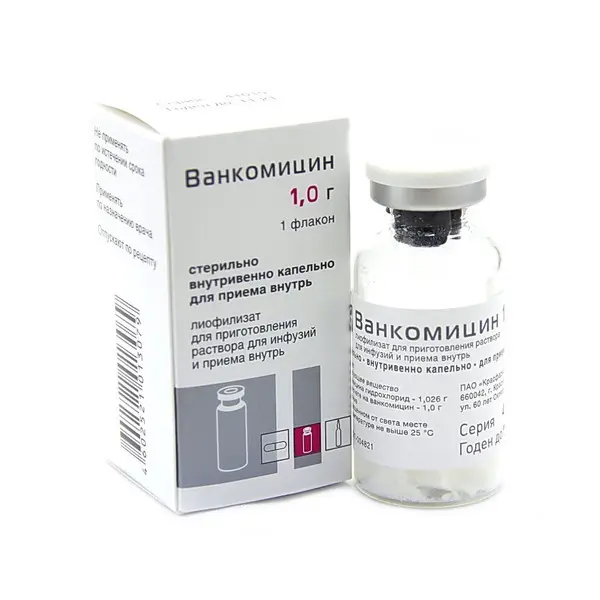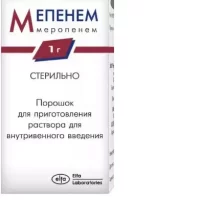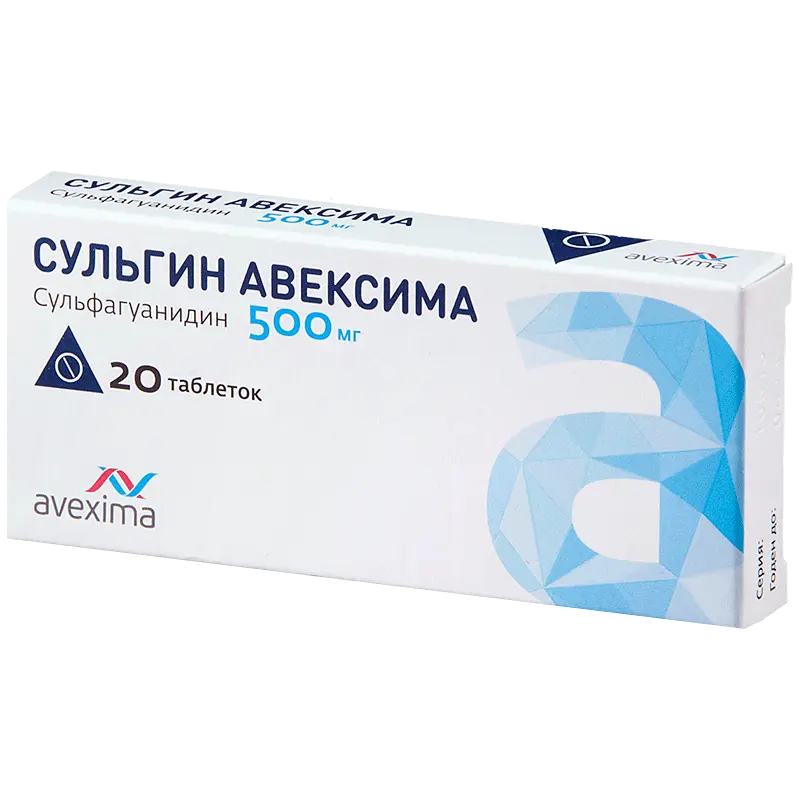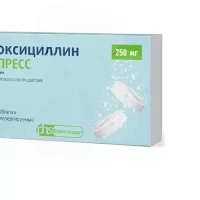Description
Vancomycin Pharmacodynamics
Vancomycin is a tricyclic glycopeptide antibiotic, produced by Amycolatopsis orientalis. Bactericidal effect of vancomycin is manifested in the inhibition of bacterial cell wall biosynthesis, can change the permeability of the bacterial cell membrane and the synthesis of ribonucleic acid (RNA). It blocks the synthesis of the bacterial cell wall at a site different from that affected by penicillins and cephalosporins (without competing with them for binding sites) by firmly binding to O-alanyl-O-alanine residues of peptidoglycan subunits (located on the outer surface of the cytoplasmic membrane), the main component of the cell wall, which leads to cell lysis.
It exhibits bactericidal action against many Gram-positive bacteria and bacteriostatic action against Enterococcus spp. Bactericidal effect on Enterococcus spp. is achieved by combined administration of vancomycin and aminoglycosides. There is no cross-resistance between vancomycin and antibiotics of other classes.
Active against Gram-positive microorganisms: Staphylococcus aureus, Staphylococcus haemolyticus, Staphylococcus epidermidis (including heterogeneous methicillin-resistant strains), Streptococcus spp. (Streptococcus pyogenes, Streptococcus pneumoniae, Streptococcus agalactiae and others, including penicillin-resistant strains), Enterococcus spp. (including Enterococcus faecalis), Clostridium spp., Propionibacterium acnes, Actinomyces spp., some strains of Lactobacillus spp., Rhodococcus spp., Corynebacterium spp., Listeria monocytogenes, Bacillus spp.
In vitro some isolated strains of Enterococcus spp. and Staphylococcus spp. may show resistance to vancomycin.
In combination with aminoglycosides synergism is observed in vitro against many strains of Staphylococcus aureus, group D streptococci other than enterococci, Enterococcus spp., Streptococcus group viridans. In combination with gentamicin, tobramycin, rifampicin, imipenem, synergism is observed against Staphylococcus aureus. In some cases, when combining vancomycin and rifampicin, antagonism of action against strains of Staphylococcus spp. is observed, this combination of drugs also shows synergistic action against some strains of Streptococcus spp.
Vancomycin is inactive in vitro against Gram-negative microorganisms, mycobacteria and fungi.
Optimum action is at pH 8, at lower pH to 6 the effect is sharply reduced.
Development of staphylococcal resistance during therapy is very rare. The value of minimum suppressive concentration (MSC) for most antibiotic-sensitive microorganisms is less than 5 µg/ml, the MSC value for vancomycin-resistant strains of Staphylococcus aureus reaches 10-20 mg/l.
When administered orally it has minimal systemic effect, acts locally on sensitive microflora in the gastrointestinal tract (GIT) (Staphylococcus aureus, Clostridium difficile).
Indications
For intravenous infusions:
Serious or severe infections caused by vancomycin-sensitive microorganisms, including Staphylococcus spp. (including penicillin- and methicillin-resistant strains), Streptococcus spp. (including penicillin-resistant strains); in allergic reactions to penicillin; in intolerance or lack of response to treatment with other antibiotics, including penicillins or cephalosporins; in infections caused by microorganisms sensitive to vancomycin but resistant to other antimicrobials:
– Endocarditis:
– caused by Streptococcus viridans or Streptococcus bovis (as monotherapy or in combination with aminoglycosides);
– caused by enterococci, such as Enterococcus faecalis (only in combination with aminoglycosides);
– Early endocarditis caused by Staphylococcus epidermidis or Corynebacterium spp. after valve replacement (in combination with rifampicin, aminoglycosides or both antibiotics);
– prophylaxis of bacterial endocarditis in patients with hypersensitivity reactions to penicillin antibiotics and heart valve disease (before dental and surgical procedures);
– sepsis;
– Central nervous system infections (meningitis);
– Lower respiratory tract infections (pneumonia, lung abscess);
– Bone and joint infections (including osteomyelitis);
– Skin and soft tissue infections.
For oral use:
– Pseudomembranous colitis caused by Clostridium difficile;
– Enterocolitis caused by Staphylococcus aureus
Contraindications
Hypersensitivity to vancomycin, neuritis of the auditory nerve, lactation.
With caution:
Hearing impairment (including history), renal failure, patients with allergy to teicoplanin (possibility of cross-allergy), pregnancy.
Pregnancy and lactation:
Use in pregnancy is possible only for “vital” indications if the expected benefit to the mother exceeds the potential risk to the fetus. If it is necessary to use the drug during lactation, breastfeeding should be stopped for the period of treatment with the drug.
Dosage regimen and administration
- Dosing regimen for intravenous drip infusion
- Intravenous (IV) dropwise. The drug must not be administered intramuscularly or intravenously by bolus (stream)!
- Adults and children over 12 years of age with normal renal function: 0.5 g every 6 hours, or 1 g every 12 hours. Each dose is recommended to be administered at a rate not exceeding 10 mg/min and the duration of infusion should be at least 60 min. The daily dose is 2 g. Age, presence of obesity may require changing the usual dose based on determination of vancomycin concentration in serum.
- Children from 1 month and up to 12 years of age: 10 mg/kg every 6 hours. Each dose is administered for at least 60 minutes. The recommended daily dose is 40 mg/kg.
Infants: initial dose of 15 mg/kg, then in a maintenance dose of 10 mg/kg every 12 hours during the first week of life; starting from the second week of life, a maintenance dose of 10 mg/kg is administered every 8 hours until age 1 month. Each dose should be administered for at least 60 minutes, and continuous monitoring of serum vancomycin concentrations is required. - The concentration of prepared vancomycin solution should not exceed 2.5-5 mg/ml. The maximum daily dose for a child should not exceed the daily dose for an adult – 2 g.
- Patients with impaired renal function require individual selection of the dose, taking into account serum creatinine level. Correction can be carried out by increasing the intervals between doses or by reducing a single dose of the drug.
- Correction by increasing the intervals between injections
- Creatinine clearance (CK) (ml/min) Vancomycin dose Interdose interval
>80 0.5 g or 1 g 12 h
80-50 1 g 24 h
50-10 1 g 3-7 days
<10 (anuria) 1 g 7-14 days - In elderly patients clearance of vancomycin is lower, the volume of distribution is greater, the selection of the dose is carried out according to the concentration of vancomycin in serum.
- In premature infants and elderly patients as a result of decreased renal function a significant dose reduction may be required. Plasma vancomycin concentrations should be monitored regularly.
- Correction of single dose depending on creatinine clearance
Creatinine clearance (ml/min) Vancomycin dose (mg/day) Creatinine clearance (ml/min) Vancomycin dose (mg/day)
100 1545 50 770
90 1390 40 620
80 1235 30 465
70 1080 20 310
60 925 10 155 - In anuria, this table should not be used to determine the dose of the drug. In anuria the starting dose is 15 mg/kg to quickly build up therapeutic concentrations of vancomycin in the serum; for stable drug concentration the maintenance dose is 1.9 mg/kg/day.
Correction by increasing the intervals between injections
In patients with severe renal insufficiency it is recommended to administer maintenance doses of 250-1000 mg 1 time every few days: in IQ 10-50 ml/min – 1 g every 3-7 days, in IQ <10 ml/min – 1 g every 7-14 days. In anuria, a dose of 1 g every 7-10 days is recommended. - Creatinine clearance is calculated from the known creatinine concentration in blood serum according to the formula:
- For men: body weight, kg x (140 – age, years) / 72 x serum creatinine concentration, mg/100 ml
- For women: the result obtained is multiplied by 0.85.
Patients on hemodialysis: the initial dose is 20-25 mg/kg, using high permeability membranes. Maintenance doses are administered based on the residual plasma concentration of the drug and adjusted to maintain a residual drug concentration of 15-20 µg/ml. - Vancomycin is effectively eliminated by hemodialysis using high permeability membranes (such as polysulfone), but is poorly eliminated using normal permeability membranes.
Patients with hepatic impairment do not require dose adjustment.
Preparation and administration of solution for infusion - Solution for infusion is prepared in two steps.
The first stage: the drug is dissolved in water for injection: 0.5 g in 10 ml, 1 g in 20 ml (solution concentration is 50 mg/ml). The solution prepared this way can be stored at room temperature (not exceeding 25 °c) for 24 hours or in refrigerator (from 2 to 8 °c) for 96 hours. - The second stage: vancomycin solutions obtained at the first stage before injection should be further diluted to a concentration not exceeding 5 mg/ml, for which they are transferred to a compatible solution for infusion: 0.5 g – in 100 ml and 1 g – in 200 ml of 0.9% sodium chloride solution, 5% dextrose solution or Ringer solution.
- The required dose of vancomycin so diluted should be administered by fractional infusion for at least 60 minutes.
- Infusion solutions of the drug based on 0.9% sodium chloride solution or 5% dextrose solution can be stored in refrigerator (2 to 8 °c) for 14 days without significant loss of activity. Solutions prepared on the basis of Ringer’s solution can be stored in the refrigerator for 4 days (96 hours).
- Before administration, the prepared solution for infusion should be checked visually for mechanical impurities and color changes.
- Dosing regimens for oral administration
- Vancomycin can be used orally to treat pseudomembranous colitis caused by Clostridium difficile due to antibiotic use and also to treat staphylococcal enterocolitis. Intravenous administration of vancomycin has no advantage for the treatment of these diseases.
- The drug should be used in the following dosages: adults 0.5-2 g 3-4 times a day, children 0.04 g/kg 3-4 times a day. The total daily dose should not exceed 2 g. The appropriate dose is prepared in 30 ml of water and given to the patient to drink or administered through a tube. To improve the taste of the solution, the usual food syrups can be added to it. The duration of treatment is 7 to 10 days. Vancomycin is not effective when taken orally for other localized infections.





